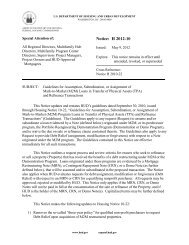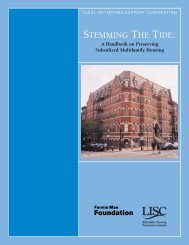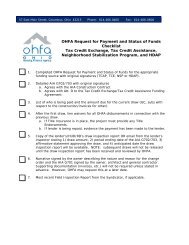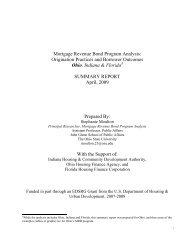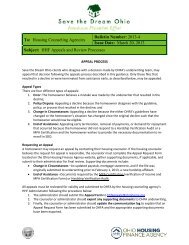OHFA Annual Plan - Ohio Housing Finance Agency
OHFA Annual Plan - Ohio Housing Finance Agency
OHFA Annual Plan - Ohio Housing Finance Agency
You also want an ePaper? Increase the reach of your titles
YUMPU automatically turns print PDFs into web optimized ePapers that Google loves.
a permanent supportive housing unit is $33 a day or $12,093 per year. This is much lowerthan the comparable cost for institutional care such as state prison which is over $25,000 ayear.In <strong>Ohio</strong>, the number of available units of permanent supportive housing, estimated tobetween 8,000-8,500 units, is inadequate for the number of persons needing it. Personsidentified as best served by permanent supportive housing include1) Homeless Persons;2) Persons with severe mental illness;3) Persons with chronic alcohol and drug addiction disorders;4) Youth aging out of foster care; and5) Offenders exiting <strong>Ohio</strong> Department of Rehabilitation and Correction’s institutionIt is estimated that nearly 20,000 <strong>Ohio</strong>ans within these five populations are in need ofpermanent supportive housing. Methodologies exist to calculate a production goal for newunits to serve identified populations, but these rely upon local and state data consistentlyacquired and commonly tabulated. A research based calculation converting the number ofpeople into a production goal of permanent housing units has been done in several localcommunities in the state. The state lacks an equivalent conversion.The creation and operation of permanent supportive housing requires funding for threedistinct and necessary components: 1) Capital to acquire property, rehabilitate existingunits, and/or to construct new units; 2) Operating subsidies to offset the rents which areusually beyond the ability of most tenants to pay (generally tenants in PSH are at or below30 percent of AMI) or to cover the cost of having security and support at the front door ofan apartment building; and 3) Service funding which pays for the staff which assists thetenants in accessing and utilizing community based services such as treatment.Nonprofit providers of PSH are at times cobbling together 10-25 different funding sources tomake these “deals” work and to operate their projects successfully. Added to the challengesin making these deals work, is the fact that historically capital is readily available, but theneeded operating subsidies and or the service funding is inadequate. Across the state,providers and local communities (referred to as Continuums of Care) have relied uponfederal and local resources, yet due to a low statewide production pipeline some of thesefunds are still underutilized. Furthermore, for this particular housing need in <strong>Ohio</strong>, the stategovernment plays little to no part in financially assisting on-going operations and serviceprovision.Research and data collected around PSH provides policy makers with irrefutable evidencethat PSH is a very strategic investment with an excellent rate of return. <strong>Ohio</strong> and its citizensare paying dearly for a lack of investment in PSH – through avoidable trips to emergencyrooms, involvement with the criminal justice system at the state and local level, demandsupon shelters and behavioral health crisis services, and other emergency services. There isalso the human cost associated with the expensive option of status quo.Therefore, the permanent supportive housing workgroup reached consensus aroundseven (7) recommendations to address the need in <strong>Ohio</strong> for increased production andsustainability of PSH.1. Better coordinate existing state resources with Federal Home Loan Bank (FHLB) tocapture more FHLB money in <strong>Ohio</strong> for PSH development.2. Facilitate an easier, coordinated process for access to multiple state resources that fosterspartnership with local organizations for PSH development and operations.108



